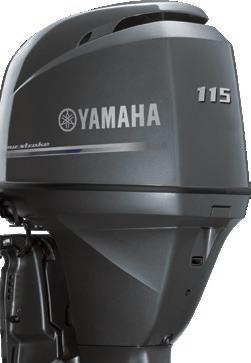



Photo Contest Winners by Caribbean
Compass editors & EPIC

Beyond Boatyards in Trinidad by
Lexi Fisher
Kelly Merton
Claudia Colli





Photo Contest Winners by Caribbean
Compass editors & EPIC

Beyond Boatyards in Trinidad by
Lexi Fisher
Kelly Merton
Claudia Colli
Publisher | Dan Merton dan@caribbeancompass.com
Advertising & Administration Shellese Craigg shellese@caribbeancompass.com
Publisher Emeritus | Tom Hopman
Editor Emeritus | Sally Erdle

Editor | Elaine Lembo elaine@caribbeancompass.com
Executive Editor
abby@berrycreativellc.com

The Caribbean is full of stories worth telling, stories found in its coastlines, its communities, and its culture. To help bring those stories into focus, Caribbean Compass and Environmental Protection in the Caribbean (EPIC) invited photographers in the month of August to share their vision of the region in the “Seas & Scenes: Love the Caribbean Photo Contest 2025.”
The response was overwhelming, with 315 photo submissions representing 31 Caribbean nations or territories and 2,824 audience votes from 81 countries worldwide. The photos and stories submitted captured a wide range of images and emotions, both above and below the water, from mountains to beaches and rocky shorelines, expressing times of joy, freedom, peace, adventure, and moments together with family and friends. These many different views, seen together in the contest gallery, showed some of the reasons that make the Caribbean a special and unique place on Earth. See the full contest gallery at epicislands.org/photo-contest-2025/ — although the voting has concluded, the “Vote Here” tab will take you to the gallery.


“Shattered Dreams, Silent Beauty,” taken at Port Royal Cays, Jamaica. A grounded sailboat symbolizes resilience and vulnerability.
Among the many remarkable submissions, three stood above the rest as this year’s first-place winners in the categories of Audience Choice, Sailing & Yachting Adventures, and Caribbean Nature & the People Who Love It. Top winning photos and stories can be viewed at epicislands. org/photo-contestwinners/2025
In the Audience Choice category, decided by popular vote, Rusty Wallace’s photograph “Where the Blues Meet the Breeze” reflects his goal of capturing “the feeling of freedom that comes from standing between two worlds — the calm, clear lagoon and the endless open sea.” Flying a DJI Mini 2 drone above Union Island in St. Vincent and the Grenadines, he described how “the island stretched like an invitation into the horizon, and I knew I had to freeze that moment of pure escape.”
The second-place winner was Stephen Sookharry with “Summer’s Sunset,” and the third-place winner was Peter Rivera with “Water Dance.”
In the Sailing & Yachting Adventures category, Sherard Little’s “Shattered Dreams, Silent Beauty” presents a sailboat run aground on the Port Royal Cays, Jamaica. Little described how the wreck “blends beauty and vulnerability, its faded sails and battered hull telling a story of nature’s power and the sea’s unpredictable mercy.” For Little, the scene symbolizes resilience, transformation, and the fragile beauty of life. “It urges viewers to appreciate Caribbean charm while respecting its formidable forces, acknowledging that love for the region involves embracing both its allure and its dangers.”
The second-place winner was Anastasia White with “The Unsung Heroes of the Sea,” and the third-place winner was Chris Layman with “A Day in the Life of an Island Soul.”
In the Caribbean Nature & the People Who Love It category, Aracelis Jimenez’s “Two Worlds at Low Tide” highlights the essential role of mangrove ecosystems. “At low tide, the waterline splits the world in two — the sky above and a nursery beneath the red mangrove roots,” Jimenez says. “I took this in the Exumas, where the water was clear enough to watch juvenile fish shelter among the mangroves. This picture reminds me of the importance of these critical coastal habitats in offering a home for juvenile fish, reducing storm-surge impacts for coastal communities, and serving as long-term carbon sinks that benefit people and nature.”




—Continued on the next page

The second-place winner was Samantha Daniel with “Stillness of the Wild,” and the third-place winner was Nicola Cornwell with “Wave Jumper.”

In total, nine photographers received cash prizes across the three categories. Their work reflects the diversity and richness of Caribbean photography and will be celebrated alongside the full collection of winners, including 16 Caribbean Choice Awards.
The Seas & Scenes contest was about more than prizes and beauty; it was about shining a light on the challenges the Caribbean faces every day and raising up the people who care about its fate. The goal was to give voice to those in the community who share their homes with millions of visitors each year and to highlight conservation, culture, people, nature, the outdoors, and all the things that make the Caribbean unique, special, and for most of us, simply home.
Heartfelt gratitude to every photographer who shared their work, to our partners who helped bring this contest to life, to the judges who dedicated their time and expertise, and to the community who engaged with the images. We also extend a special thanks to our sponsors, IGY Marinas and Horizon Yachts International, for their invaluable support in celebrating the Caribbean. To learn more about the individuals who shaped this year’s selections, please visit our judges’ page: epicislands. org/judges-page/
HAL Represents a New SSCA Member Benefit
The Seven Seas Cruising Association (SSCA) has introduced HAL (Hybrid

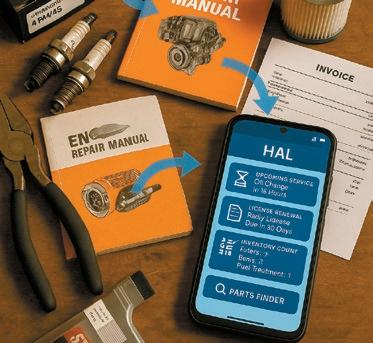
HAL does the work of … well, take a look.

Applied Layer), a maritime AI partner designed specifically for members. HAL is not a chart plotter or navigation system — it is a text-based assistant, a captain’s autopilot for navigational information. Running inside ChatGPT, HAL controls the time, sources, and data it uses, ensuring that answers are valid. Based on curated government sources, it is maritime-specific and up to date.
With HAL on mobile, tablet or laptop in one window, members can:
• Review the latest navigation updates (LNMs, AtoNs, dredging notices) in one fused view.
• Use Android/Apple/Windows, use cell internet service or Starlink.
• Access Coast Pilot, LNM and Light List data quickly in one text view.
• Use unique commands to view port and location/customs information from government data systems.
• Run short “Did You Know?” briefings for small boat operations.
Members can experience HAL in person at Melbourne GAM, November 14–16, 2025. SSCA volunteers and HAL developers will host workshops to help members install HAL and demonstrate its advanced features. Please request your copy via the HAL Forum in ssca.org (select using your profile and add HAL FORUM to your interests). This requires a ChatGPT account, free or paid (PLUS) and installs via an internet link from ssca.org
To explore HAL in action, view the presentation at online.fliphtml5.com/ kvzjf/vobz/
—Continued on the next page

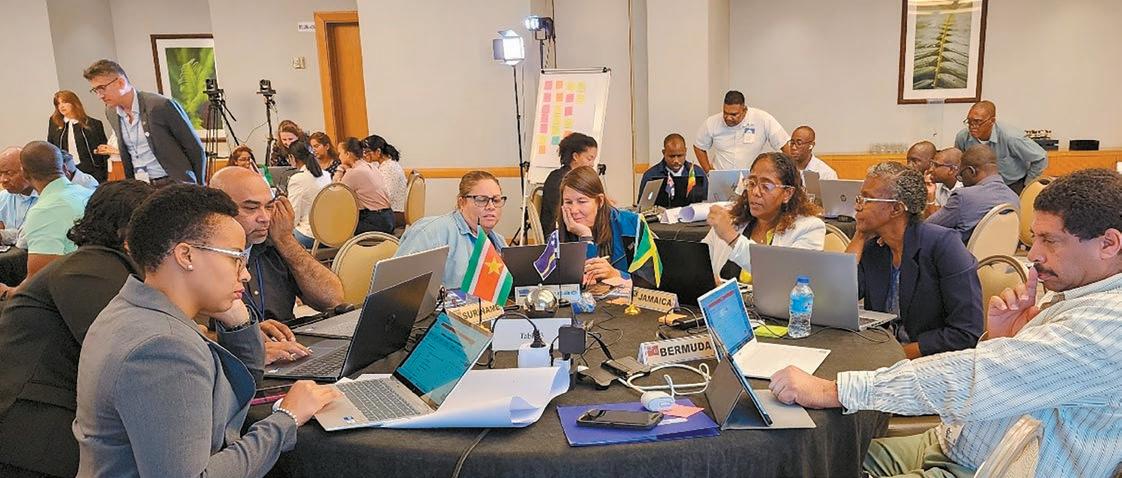

The British Virgin Islands are the self-proclaimed sailing capital of the world, and now they have the trademarks to prove it. The BVI Tourist Board & Film Commission (BVITBFC) has announced that the territory has officially secured three new trademarks: The British Virgin Islands - Sailing Capital of the World™; British Virgin Islands - The Undisputed Sailing Capital of the Caribbean™; and The British Virgin Islands - Sailing Capital of the Caribbean™. Each mark has been formally registered for a period of 10 years, beginning May 7, 2024.
“The British Virgin Islands has long been recognized as one of the best sailing destinations in the world thanks to our steady trade winds, navigable channels, manageable currents, multiple islands and protected bays,” said Clive McCoy, director of tourism for the British Virgin Islands. “Securing these trademarks is a powerful step in protecting our identity, strengthening our position in the international market and ensuring that travelers, sailors and partners alike associate the BVI with sailing excellence.”
The BVITBFC also announced the successful completion of its second annual tourism summer internship program, designed to give participants hands-on training and exposure to diverse career paths.
This year, ten students were placed across some of the BVI’s premier hospitality properties, including Rosewood Little Dix Bay, Scrub Island Resort, Peter Island Resort & Marina, Nanny Cay Resort, and Necker Island.
Of note:
• Auri-Ana Elshabaz (BVI’s 2025 junior ambassador of tourism) was offered a full-time position at Peter Island Resort that started in
October 2025.
• Roman Nibbs was offered a part-time role at Scrub Island starting October 2025.
• Jayla Winter was offered a part-time role at Scrub Island during the Christmas break.
• Shajayla Hodge: Nanny Cay Resort recognized Shajayla for her outstanding performance at the resort, and would have offered her a full-time role, if one was available.

Tom Cunliffe’s Hurricane Force
Tom Cunliffe, award-winning author of over 25 technical books and the star of two BBC series on sailing, has released his first novel, Hurricane Force
Alexander McCall Smith (No. 1 Ladies Detective Agency) has written, “Tom Cunliffe is set to become the Dick Francis of the sea. This highly readable novel is nail-bitingly exciting as well as being very well-written. Exceptionally enjoyable.”
Caribbean Compass will present the first chapter of Hurricane Force in an upcoming issue. Look for it!
The Media Institute of the Caribbean, with UNESCO support, has published a new report, announces the publication of “Disasters and Crises in the Caribbean Region: A Review of Experiences in Seven Islands,” reviewing disaster communication across the region.
It emphasizes the region’s vulnerability to crises and the vital role of timely, culturally sensitive communication. Findings highlight how media resilience and journalist efforts are crucial in saving lives, combating misinformation, and aiding recovery.
The report urges investment in newsroom safety, training, and stronger partnerships among media, governments, and aid agencies. President Kiran Maharaj calls it a “call to action,” stressing that robust communication infrastructure is essential for survival, development, and democracy in the face of climate and health emergencies.
Read the report at online.flippingbook.com/view/970074714/


Environmental Fridays: November highlights
Environmental Fridays, the Zoomcast lecture series organized by Doctor Desmond Murray, has some November events of particular interest to the Caribbean and the sailing community. On November 7, meet Trinidadian Jayda Ramjattan , a 15-year-old poet/artist/ UNICEF Child Rights Ambassador and much more, speaking on The Autobiography of a Teenage Environmentalist
On November 14, learn about what the average citizen can contribute to the field of environmental science when University of Florida Professor Corey T. Callaghan speaks on The Role of Citizen Science in Biodiversity. And on November 21, Professor John J. Wiens of the University of Arizona takes on Biodiversity, Extinction, and Climate Change.
The lecture series, which is now partnered with Caribbean Compass and recently featured Compass editor Elaine Lembo as a co-host, is Zoomcast on Fridays at 9:30am (EST); Zoom Meeting ID: 834 1808 4388.

Elkhorn Releases Annual Report
Elkhorn Marine Conservancy (EMC) has released its latest annual report, highlighting a year of growth, innovation, and impact in the effort to restore Antigua’s coral reefs and engage the community in marine conservation.
Now in its fourth year of operations, EMC has expanded its coral restoration network to include four underwater nurseries across the island. By selectively propagating heat-tolerant corals, EMC achieved survival rates above 70 percent during the 2024 bleaching event, an accomplishment that stands out across the wider Caribbean. In total, more than 4,700 coral fragments are now being cultivated, with 2,000 outplanted to reefs on the east and southwest coasts.
EMC’s research and conservation efforts have also advanced. The team published a peer-reviewed paper in Restoration Ecology, contributed to shark tagging and whale monitoring programs, and collaborated with local and international partners to expand scientific knowledge and best practices in reef recovery.
Community engagement remained a cornerstone of EMC’s work. In 2024, the organization engaged the community through educational programs, hands-on experiences at its coral nurseries, and a variety of outreach initiatives for learners of all ages. EMC’s annual Making Waves fundraiser and partnerships with international initiatives also helped amplify its mission locally and abroad.
As it enters its fifth year of operations, EMC is poised to expand restoration efforts, advance research, and continue fostering a deeper connection between the community and Antigua’s marine ecosystems.
The full report is available at static1.squarespace.com/ static/6026c6851f90da6917f0e341/t/68c85bdfd19191578372b7e4/1757961183455/ EMC+Annual+Report+2024-2025+_compressed.pdf
The Wildlife Conservation Society (WCS) has launched its 2025–2030 Coral Reef Conservation Strategy, a global plan to protect the world’s most climateresilient coral reefs. Drawing on 40+ years of experience and new science, the strategy centers on High Integrity Climate-Resilient Reefs (HICOR) — reefs with enough live coral, species diversity, and fish biomass to resist and recover from climate impacts.
Coral reefs cover less than 1 percent of the ocean but support over 25 percent of marine species and nearly 1 billion people. Yet, climate change has devastated them — over half of live coral is gone, and the worst bleaching event on record has affected more than 80 percent of reefs globally.
“There’s still hope,” said Dr. Stacy Jupiter, WCS’s Global Marine Program lead. “Some reefs are defying the odds. If we find and protect them, they can help

drive recovery.”
Led by Dr. Emily Darling, the strategy sets three goals: identify HICOR, safeguard them through integrated conservation, and connect people to drive systemic change. By 2030, WCS and partners aim to:
• Map climate-resilient reefs to guide global investment
• Expand protection to include HICOR in 30 new marine protected areas
• Reduce threats across 100,000 km² of coastal zones
• Support five national coral reef action plans
• Mobilize 31 countries to commit to reef protection by COP31
• Elevate HICOR in science and media through 50+ publications.
“This is about more than saving coral,” said Darling. “It’s about building a future where oceans thrive and hope endures.”
Read the full strategy: https://doi.org/10.19121/2025.Report.52213
Product highlights from Budget Marine
Expanded fishing gear lineup: Budget Marine is revamping its fishing inventory. Boaters can look forward to a significantly enhanced selection, including an impressive range of Boone trolling lures — a favorite among cruising yachts for game fish.
Improved hull cleaning solutions: Keeping hulls clean is an essential task for cruisers, especially when dealing with stubborn barnacle growth. Budget Marine has identified a highly durable scourer from Sanfine Tools for keeping hulls, especially dealing with stubborn barnacle growth. This new solution will now be available at all locations.
SFA marine toilets: Budget Marine now stocks a full range of SFA replacement parts and accessories across its network.
For more log on to budgetmarine.com
Yanmar Dealership opens in Antigua
Yanmar is establishing a dealership at Jolly Harbour Marina & Boatyard, Antigua, operated by Ivan DeSouza, proprietor of Nautical Marine Services (formerly Xtreme Marine). The new building, adjacent to the main gate to the twin piers (catamaran lifting area) in Yard 1, will be ready for the opening to tie in with the start of the 2025/26 season.

Also joining the team will be Jerell Jules, who has worked for the business as casual labor since he was in high school. Jules will work on the docks and at the fuel dock; during the summer months, his efforts will be concentrated in the boatyard.
The refurbishment of Yanmar’s Superyacht Dock piers is complete. Since demand is high and space is limited, making a reservation is recommended. For more log on to jhmarina.com
Story and photos by Kelly Merton
For over three decades, the mere phrase “Antigua Classic Yacht Regatta” has summoned dreamy visions of glass-like varnish, towering wooden masts, crisp white sails, and elegantly dressed sailors participating in the ultimate “gentlemen’s race.”
What’s far less expected — but arguably far more fun! — is the deeplytanned, sunglass-free woman wearing a well-worn woven straw hat and a shockingly vibrant purple tropical shirt who greets me as I walk the docks of the famed Nelson’s Dockyard in Antigua’s English Harbour, on day two of the 36th Annual Antigua Classic Yacht Regatta in late April 2025. A faintly German accent accompanies her bright smile the first time I hear Angie Wolf, owner/ skipper of S/V Cherub, greet me and welcome me aboard her lovingly restored 42-foot gaff-rigged Venus ketch.
Once aboard, I am greeted by a chorus of international accents accompanying friendly faces, as the all-female crew introduce themselves in rapid-fire succession. First it’s Meg, originally from New Zealand, but now calling the slopes of British Columbia’s snow-cat country home. Next are the Canadian mother-daughter team of Krissie and Dairan, American expat turned full-time Caribbean cruiser Vanita, and from England, former nurse Janet — whom I’ll come to learn is one spirited sea-shanty singer! While all these ladies are experienced sailors in their own right, the Classic regatta marks the first time many in the crew have not only sailed together, but also sailed aboard a gaff-rig.
Thankfully, however, not everyone aboard is a gaff-rig newby. Two of Angie’s friends, Bronwen and Coralie, regularly sail with her in the Grenadines and bring to the regatta crew some much-needed gaff-rig experience. In the days preceding the regatta, they have completed the three-day, 160-nautical-mile (~300 km) delivery sail from the tiny island of Carriacou to Antigua.

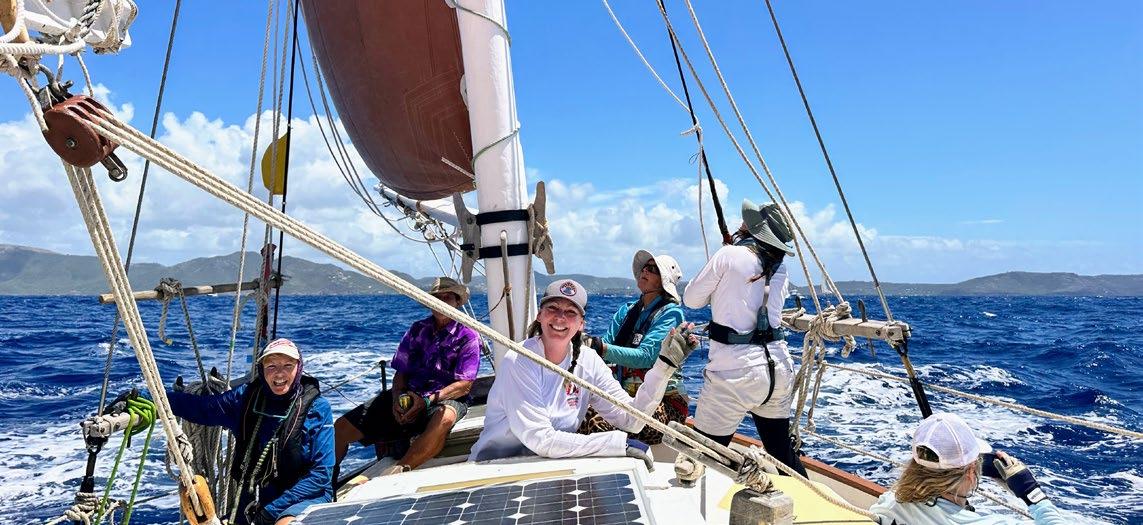
The crew’s collective confidence soared as they secured a class second in only the second time they’ve sailed together.

With crew introductions in the book, dock lines are cast off, Cherub emerges from her Med-moored slip. Despite shaking off the lingering effects of a few boat drinks imbibed the previous evening, the crew are in excellent spirits. Day one served up a mix of big air, lumpy seas, and generally sporty conditions, so their collective confidence soars as they secure a class second in day one’s race (and only the second time this crew sailed together!). As sails go up to a bellowed chant of “one ... two … hoist,” fragmented choruses of popular Jimmy Buffett and Zac Brown Band songs excitedly spill from the lips of Jan, Dairan, and Krissie. It’s time for another day of racing and everyone is ready!
—Continued on the next page
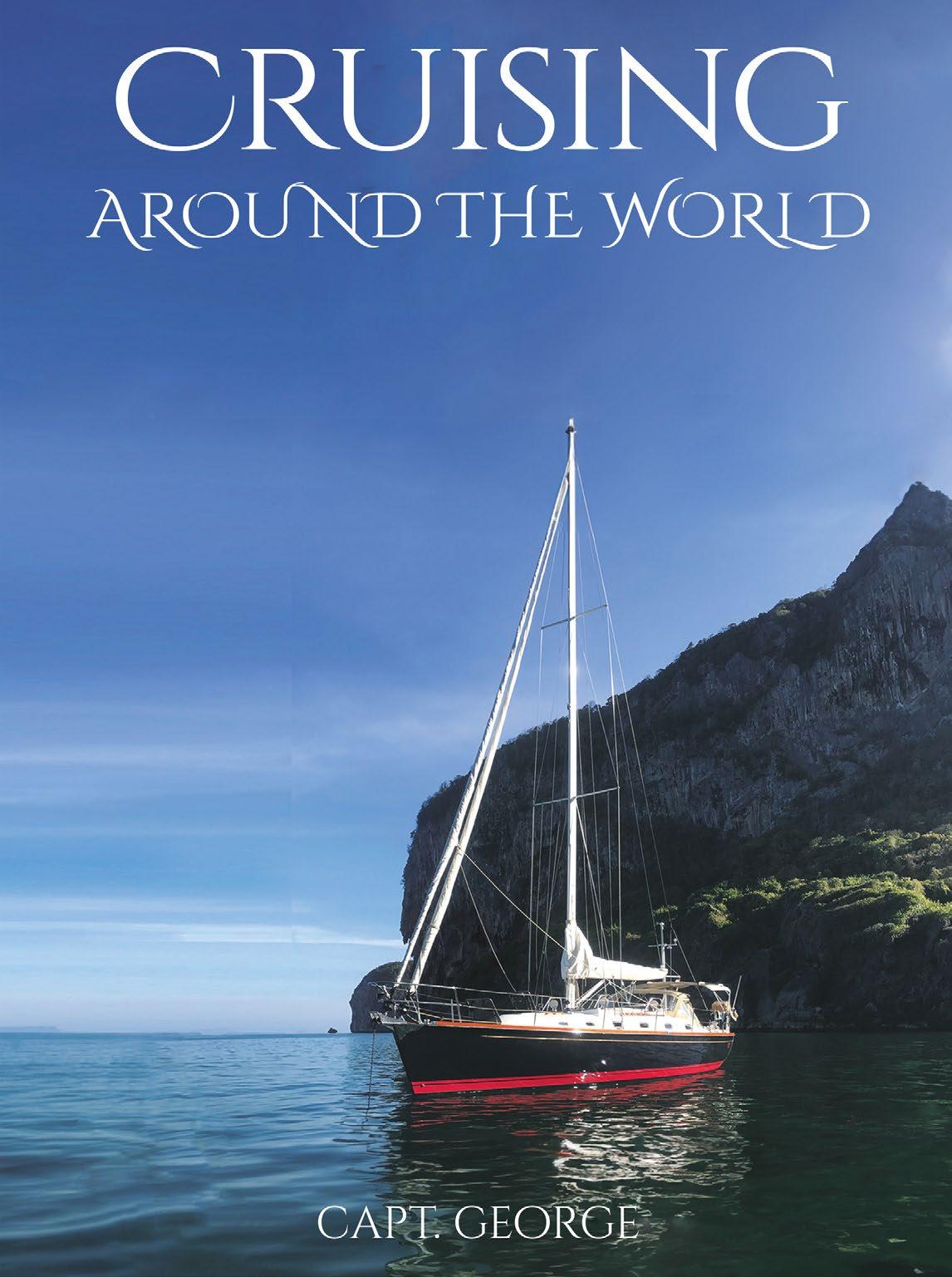
Captain George’s new book is now available on Amazon in all formats ebook, paperback, hardcover, and audiobook.
—Continued from the previous page
Sea Swan, to a class-second in the 2023 Antigua Classic.

As Cherub and her fellow competitors begin emerging from the protection of English Harbour into the Caribbean Sea, the most unexpected visitor suddenly appears in the already-at-capacity cockpit: a cat! I quickly come to learn this feline friend, affectionately known as “Woozle,” was a package deal with the boat when Cherub came into Angie’s possession three years prior. Woozle — like Cherub herself — was beloved by the boat’s former owner (and Venus fleet designer) Paul Erling Johnson. If his name sounds familiar, you’re either a niche-boat design enthusiast or quite the cinephile, because in addition to being the subject of a number of articles (including one starting on page 18 in the Oct 2020 issue of Caribbean Compass), Paul was the subject of an award winning 2021 documentary about his life and career, aptly named The Sailor.
As the clock inches towards the 10 a.m. start time and regatta participants make their way north, it’s immediately evident that it’s a “champagne sailing” kind of day featuring bright skies, 12-15 knot sustained breezes, and gently rolling seas.
When the fleet approaches the starting area, we’re met with what is likely one of the most gorgeous yachts ever to serve as a regatta committee boat. Marie is a 1930s-vintage 136-foot motor yacht that has explored the world many a time before being meticulously restored. With her dark, glossy hull, crisp canvas, and glistening varnish, one envisions refined tea parties of high society yesteryear, not multi-boat tussles for the favored end of a regatta starting line.
After a bit of tacking around in the starting area, a gun sounds, and the Day Two race is officially underway. Despite being later to the line than one might hope, Cherub finds clear air and settles into the first leg of the 20-nauticalmile “butterfly” course, one of the longest in the regatta. After crossing the starting line, competitors first head four miles west to a mark known as “Cupples,” the first mark in all of the preannounced courses, named in honor of the regatta’s beloved, late, and longtime race chair, Ms. Clare Cupples.
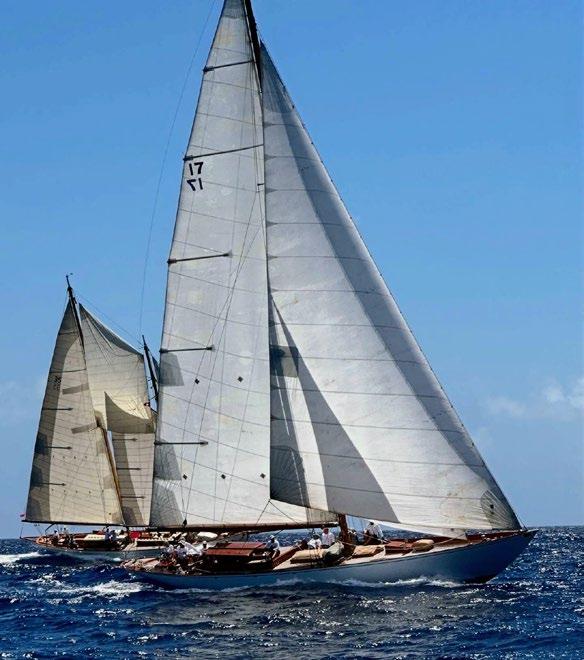
As Cherub and the fleet approach the first mark, a bit of traditional racing drama ensues. Because Angie knows gaff-rigged boats don’t point very high, her plan is to hold her course while intentionally overshooting the mark, then head farther out to sea in an attempt to get closer to the Cape Shirley turning mark layline. But just to starboard, the tactician of Sahret of Tyre, a 32-meter (106-foot) 1933 Bermudian ketch, is calling for us to tack. He’s claiming that they’re the leeward boat, so he tries to push us up and over early. And while it’s true they are to lee of us, we’re within the three-boatlength circle of the turning mark, so he wants to supersede the typical rule — Rule 18 in the Racing Rules of Sailing (RRS), the rules that govern the regatta. But despite much boat-to-boat shouting and Sahret’s attempts to intimidate us out of our fairly-held position, Angie knows her rights and holds her course. On Angie’s call, Cherub successfully tacks away and heads for Cape Shirley. And while this sort of energetic banter at the mark is par-for-the-course for an experienced racer, for this crew of cruisers, the rounding proves to be an adrenaline-inducing experience! The crew busies itself with a passionate debriefing and accolades for Angie’s composure, knowledge, and skill.
As Cherub rounds the mark at Cape Shirley, the experience of tactician Bronwen is on full display. Wearing an eclectic mix of brightly colored tropical and bold animal prints, she confidently instructs the crew to set the sails on opposite sides of the masts, sending Cherub on a wing-on-wing downwind run. A dead-down(wind) course may be considered a bit risky by some, due to the potential for an accidental broach, but Bronwen is no stranger to these waters or conditions, as she successfully skippered her 1966 34-foot Morgan,
While Angie ever-so-slightly coaxes the massive wooden tiller to catch the gentle rolling waves hitting our stern, Bronwen’s soft, sing-song South African accent can scarcely be heard beyond the cockpit as she praises Angie for her excellent driving. Angie remains deeply connected with the boat and water for the duration of the seemingly endless leg.
But finally, the downwind leg is complete and we’re back at the entrance to Falmouth Harbour. However, despite having already logged two hours of race time, we’re only at the halfway point, as Cherub still has to sail the other wing of the butterfly course. But time has been good to the crew, and everyone has clearly settled into her job.
Although the cockpit is a fairly cozy space, Megs and Jan have found operational cadence with Angie and Bronwen at the back of the boat. The lifelong bond of Krissie and Darian is evident as they work seamlessly to keep the sails aloft trimmed to perfection, while Vanita, positioned midship, remains focused on the flying jib, acting as eyes for the trim team in the cockpit. And on the bow, it’s the enigmatic Coralie who’s the star of the show. Her bare feet adeptly propel her to the end of the cantilevered wooden bowsprit as she makes minor tweaks to the sails. When I ask her about her sailing experience, in a thick French accent she coyly replies that she only began sailing when she first arrived on Carriacou six years prior. This is hard to believe, as she’s clearly a natural!
After a near-miss of a passing squall, the ladies enjoy a calm, blissfully shaded final leg. The following seas gently roll the boat forward and a trancelike state takes hold of Cherub, and it’s in this leg that we simultaneously recognize both our shared and individual good fortunes. We have the health and time and connections to simply be present — and in each other’s presence. While the crew ranges in age from 20s to 70-ish, we share a recognition of all the individual moments that have brought us aboard a beautifully restored — and perpetually loved — unique old boat, on a top ten day, with a group of confident, empowered, and downright fun women. This is not for a moment lost on anyone, and I can personally say that this day has been the pleasure of a lifetime.
Krissie’s voice rings out as she hails the committee boat on the VHF, announcing our imminent crossing of the finish line. After over four hours of racing, Cherub is done. And with the confirmation of completion from the race committee, the formerly all-business (okay, mostly-business) crew shifts into party mode. In what feels like seconds, the ever-bubbly Darian stealthily pops below, and emerges in the companionway distributing ice-cold cans of Carib lager. Megs materializes from the galley offering me a Carib, but I decline, murmuring I’m not much of a beer drinker. That assertion seems to be music to Bronwen’s ears, as she kindly but excitedly suggests I try one of the rum cocktails Megs has whipped up the prior day. And who am I to say no after such a special day?!
Rum drink in hand, I take a seat in the cockpit next to Angie as Bronwen helms us home. Without prompting, Angie begins sharing details about her dear departed friend. With a fond but longing smile on her face, she speaks about his passion for designing beautiful boats to sail the world, and his love of women.
To understand Angie’s love for the Venus, it helps to understand a bit of the boat’s back story.
—Continued on page 11
Registration is officially open for the 37th Antigua Classic Yacht Regatta, one of the premier classic sailing events worldwide, set for April 15–20, 2026 in the UNESCO World Heritage Site of Nelson’s Dockyard, Antigua. The ACYR is a celebration of sailing heritage and camaraderie, bringing together new entries and returning yachts, alongside the volunteers, sponsors, and photographers who make the event a highlight of the sailing calendar.
Find details about registration for the race, including eligibility requirements, at https://antiguaclassics.com/wp-content/ uploads/2025/09/2026_AntiguaClassics_NOR.pdf.
Yachts registering and paying before March 1, 2026, will receive a reduced entry fee. Register at https://www.yachtscoring.com/ emenu/50482.
The Grenadines — an exquisite chain of island gems scattered like jewels in the southern Caribbean — have long captivated travellers in search of authenticity, natural beauty, and barefoot luxury. But while the destination has always delivered on charm and seclusion, many visitors have asked the same question over the years: “What’s the easiest way to get there?”
The answer today is simple: via Barbados.
Thanks to seamless regional air connectivity with SVG Air, the journey from Barbados to the Grenadines has never been more convenient, comfortable, or time efficient. Whether you’re planning to unwind in Bequia, explore the chic exclusivity of Canouan, or discover the underwater world filled with vibrant coral reefs and diverse marine life of Union Island, Bridgetown’s Grantley Adams International Airport offers the most direct gateway to paradise flying with SVG Air.
Why Barbados?
As one of the busiest and best-connected hubs in the Eastern Caribbean, Barbados receives daily international flights from the UK, US, Canada, and across the region. Travellers arriving at Barbados can connect to SVG Air’s scheduled and charter flights to multiple Grenadine islands — skipping the stress of ferry transfers or complicated multi-leg journeys.
With SVG Air’s dedicated meet-and-greet team and priority handling at Grantley Adams, passengers are escorted through to the domestic lounge — no clearing of immigration or customs needed — where the onward flight to their island destination awaits. No overnight stays, no missed connections, no lost momentum.
Ferries between St. Vincent and the Grenadines, while scenic, are subject to weather disruptions and limited schedules. They also require an overnight in St. Vincent for most international arrivals — a cost and time factor many travellers would prefer to avoid. In contrast, flying directly from Barbados to your Grenadine island means you can be checked into your villa, rum punch in
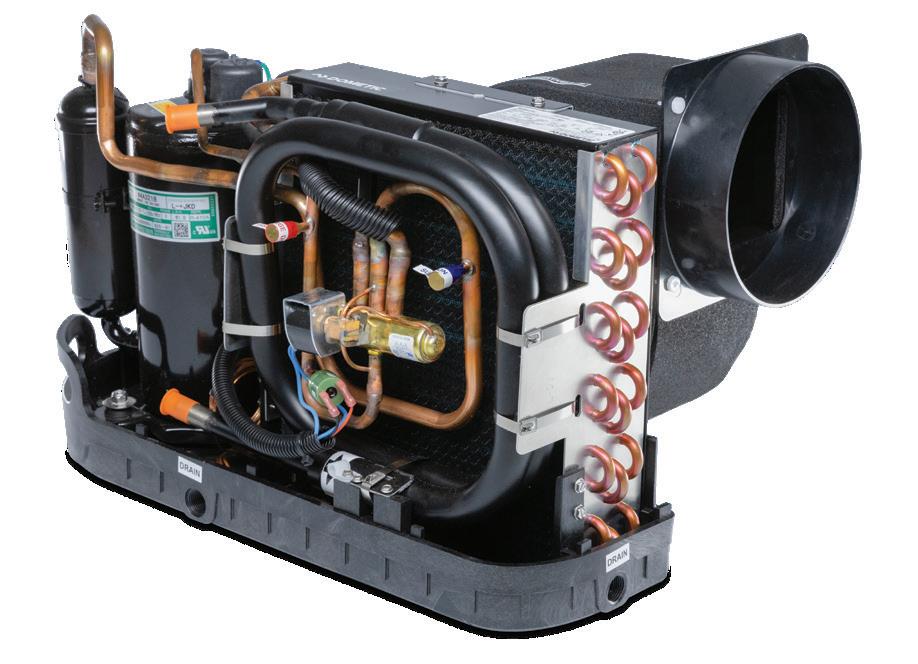
hand, by the afternoon.
SVG Air offers scheduled services to Bequia, Canouan, and Union Island, and charter options to Mustique and beyond. With smaller aircraft and faster turnaround times, we’re uniquely positioned to get you where you need to go — on your time.
In the aftermath of Hurricane Beryl, restoring reliable air access has become even more critical to the recovery of the Southern Grenadines. SVG Air remains committed to keeping the islands connected — not just for visitors, but for the communities and livelihoods that depend on tourism. By flying through Barbados, you’re also contributing to the resilience of these islands.


Travellers can book SVG Air flights directly at www.flysvgair.com or speak with their travel advisors to coordinate connections via Barbados. Group charters, luxury private jet handling, and tailor-made itineraries are also available for those seeking a more bespoke experience.
When it comes to exploring the untouched beauty of the Grenadines, the easiest way in is clear: start in Barbados and let SVG Air take you the rest of the way.


—Continued from page 9
The 42-foot Cherub is a Venus 6, so named because she was the sixth boat designed by Johnson back in 1976 in Bermuda. Though he originally designed her for a client, Cherub boomeranged back to him after his own boat, a Venus 38, was shipwrecked off the coast of Martinique in her maiden voyage. After Paul was heroically rescued by helicopter, Cherub’s owner gave this boat back to him, and for over 40 years, he loved Cherub as much as Angie has loved her for the past four years.
Prior to his passing in 2021, Paul was lucky enough to have Angie as his increasingly formal caretaker. As his health declined and Angie progressed from his on-water food delivery provider to vodka rationer to medical aide, he came to rely on this former geriatric nurse as his constant companion. As friend and marine photographer Jan Hein recalls, “her company was gold to Paul,” so it makes sense that he chose to bequeath to Angie his beloved Cherub
From 2021 to 2024, Angie threw herself into restoring Cherub to her original splendor. Three years of painstaking work had just been completed in spring 2024 when the unthinkable happened: on July 1, 2024, a powerful, early season Category 4 hurricane Beryl slammed into the previously safe Southern Grenadines. Islands in the chain, including Carriacou, endured hours of sustained winds of over 150 miles per hour. Homes and businesses alike had roofs ripped off, trees were uprooted, and countless vessels, Cherub among them, were battered and tossed like toys deep into the mangroves of Tyrell Bay. In the immediate aftermath of the storm, friends recall Angie being the hero and glue of the island. Hein recollects hearing from locals about all Angie did to help the dozens and dozens of boats trashed by Beryl. “Some folks are takers,” shares Hein, “and a few, like Angie, are givers, through and through.”
And so the success of Cherub and her all-woman crew at the 2025 Antigua Classic Yacht Regatta isn’t lost on Angie Wolf. This “little boat that could” finished the regatta in a very respectable second place in her class, with a corrected time of less than a minute over the third-place finisher in a four-hour race; for Angie, the real victory was simply showing up.
What’s next for Angie and Cherub isn’t entirely clear. She knows she wants to empower women and enjoy life, but she plans to see where the wind takes her. Like so many of her friends, I know I’ll always look to the horizon, seeing if I can spot her faded red sails in the sunset.

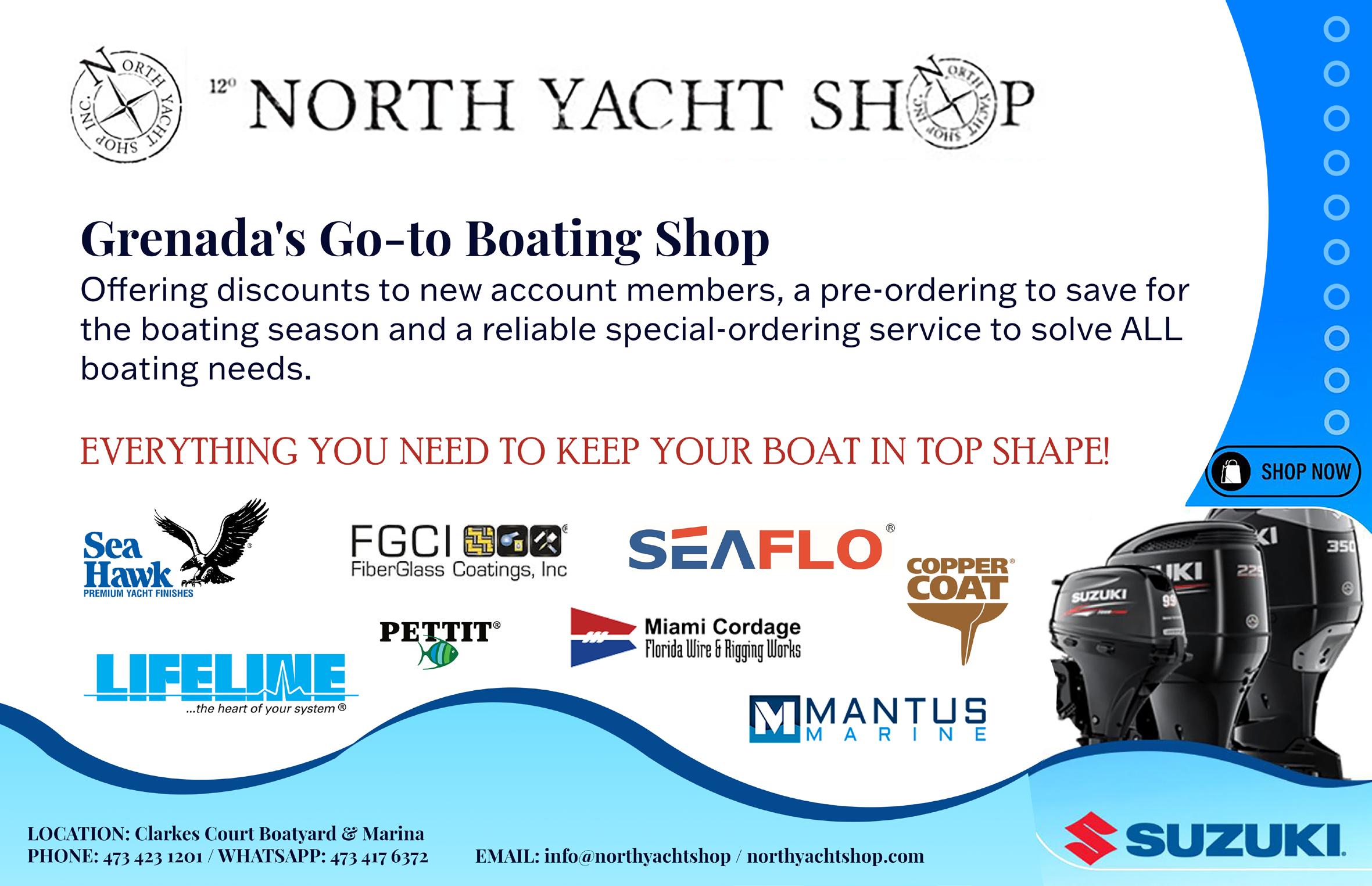

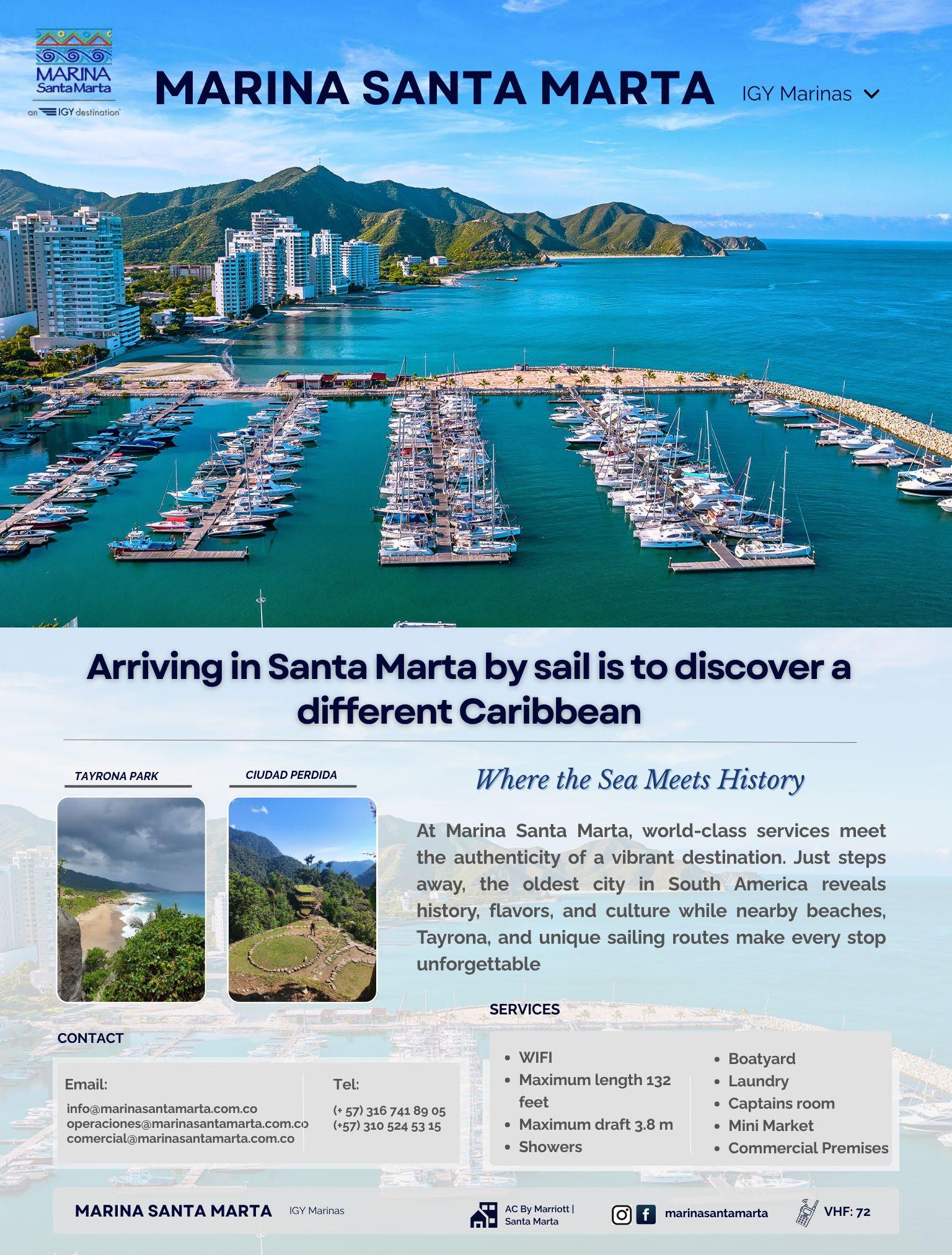
Story and photos by Lexi Fisher
Though I’ve spent significant time in Trinidad working on boat projects over the years, our Trinidad & Tobago guide content hadn’t been updated since 2012. In the years that followed, the local yachting industry dipped, mostly because of security concerns linked to unrest in nearby Venezuela. Between 2015 and 2019, there were a handful of piracy incidents between Grenada and Trinidad. The Trinidad government took it seriously, increasing coast guard patrols and creating a floatplan program with North Post Radio. It’s been effective, with no incidents since 2019 (see Caribbean Safety and Security Network, thecssn.org, for details).

As boats began returning, many were surprised by the welcome they received. One cruiser told me, “Everywhere else we’ve hauled out, it felt like they were doing us a favor. Here, it’s been the opposite.” Service providers know cruisers remain wary and have built a reputation for going above and beyond.
While news reports about Trinidad’s crime rate can also be alarming, the reality for visiting sailors is different. Most of it is gang-related and concentrated in the capital, Port of Spain. Chaguaramas, the island’s yachting center, is considered safe from violent crime, and for a while, Trinidad seemed like a bit of an industry secret. Then, in early 2024, Hurricane Beryl pushed yachts south from Grenada in search of safety. While some yachts only stuck around long enough to wait out the storm, others stayed to explore. Most left with a positive impression. With hurricane unpredictability on everyone’s mind, it seemed like the right time to finally update the guide.
It was May 2025, and I had just finished updating our Windward Islands content. I was looking forward to spending some time at my desk, but if I wanted to get the Trinidad and Tobago updates out before the end of hurricane season, then now was the time to do the research. And so, my father Jeff and I set off from Grenada on Ti Kanot, a 40-foot catamaran, back to where she was built in the yachting center of Trinidad — Chaguaramas.
The last time we’d checked in pre-Covid, boats were required to tie up at the customs dock immediately upon arrival and then go to the customs and immigration offices to fill out endless triplicate forms. This time, the officer asked for our “Port Health Clearance” (AKA Maritime Declaration of Health Form). Confused, we learned it was a Covid-era form that had stuck around, and that since then, the major marinas had been processing the health form for their customers in advance of arrival and compiling it with all the other required paperwork, for them to take to the customs and immigration offices. It’s more work for the yard offices, but it simplifies the process for cruisers.
I pulled out the trusty old folding bike and lugged it ashore to start my rounds. After a few days of pounding the pavement visiting businesses and taking photos and notes, I decided to get up early to explore the nearby 135-square-mile Chaguaramas National Park. One of my goals for the guide was to not just update the many general and technical yacht services in the area, but also to encourage yachtspeople to explore beyond the yards and experience some of the wonderful and unique ecological and cultural attractions Trinidad has to offer — one of which is right in the middle of Chaguaramas: Bamboo Cathedral and the howler monkeys that often gather
there in the early mornings. Trinidad’s ecology is more similar to that of Venezuela and South America than the rest of the Caribbean, and it is the only Caribbean island where howler monkeys are found. With their calls able to travel up to three miles away, they are the world’s loudest land mammals, and recordings of them were used as part of Jurassic Park’s sound effects for T-Rex.
When I got to Bamboo Cathedral a handful of monkeys were there, swaying in the arches of criss-crossed bamboo, totally unbothered by the walkers and cyclists passing below. At first, they were silent, but then one of them started, and a cacophony followed. Stretching the deep Os of their mouths like megaphones, they projected deep, throaty howls, reminiscent of diesel engines in desperate need of servicing. I could almost feel them reverberating through my body. It was spectacular, this mind-boggling noise coming from such average-looking monkeys sitting in the treetops.
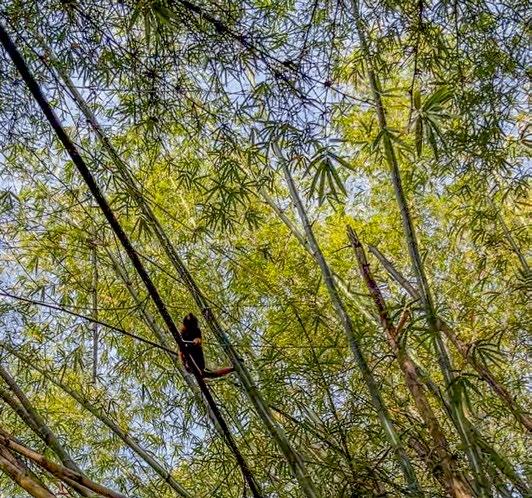
I could almost feel the deep, throaty howls of the howler monkeys reverberating through my body
I was also looking forward to visiting the main local market where hundreds of vendors sell local fruits, vegetables, bottles of hot sauces, local spices, cuts of fresh local meat, and dozens of types of fresh fish. There are also massive grocery stores, shopping malls, and a Costco-like wholesale store, all a short bus ride away, but the market is the place to go for a truly local experience. Jesse James’s taxi service organizes multiple weekly shopping trips that pick up and drop off from the boatyards so you don’t have to lug all your bags back on the public bus; other groups have the same service. I took the shopping bus, and met a family that was planning to do the Caroni Swamp tour the next day. I had done the tour years ago but was eager to join them and do it again.
The term “swamp” doesn’t do it much justice. It’s a 6,000-hectare Wetland of International Importance under the Ramsar Convention with mangrove forests, brackish channels, and intertidal mudflats. After getting us seated in the large pirogue, our tour guide started the outboard and putted us down the muddy channel. Mangroves encroached on either side, their prop roots reaching down from high above and more than once forcing us to bob and weave our heads out of their way. It wasn’t long before the guide pulled us alongside the channel to point out a couple of owls hiding among the branches, and then a tree boa curled tightly in the branches above the boat. Herons and egrets stalked the treeline for unlucky crabs, and kingfishers trilled as they swooped among the branches. We pulled over again to look at a silky anteater, the world’s smallest species, that looked like nothing more than a ball of light brown fuzz barely larger than a fist.
—Continued on the next page
—Continued from the previous page
And then it was time for the show we had all come for. We motored to the other side of the lagoon, tied to a post, killed the engine, and waited quietly. It was late afternoon, and the sun hung low in the sky behind us. Minutes ticked by, and I started to get nervous. What if they didn’t show? And then, from the distance to our left, a handful of bright red scarlet ibis emerged from over the treetops and swooped down onto the mangrove island in front of us. And then another, and another, until dozens of them were circling and settling into their roost. The golden light of the setting sun emblazoned their already fiery-red feathers and long, pointy beaks, and they almost seemed to glow. “Oooh”s and “Ahhh”s rolled over the group as we sat entranced.
We also spent some time exploring the nearby offshore islands of Gaspare Grande, Chacachacare, and Monos. Monos and Gaspare Grande are populated with holiday homes, but Chacachacare is a former leper colony where most of the buildings are abandoned. Exploring ashore is an interesting, if not eerie, experience.

The setting sun turned the Tobago sky into one of those breathtaking Caribbean sunsets that sets the clouds on fire.
And then it was time to head to Tobago. I lugged the bike back to the boat and my dad went to deal with Customs and Immigration. Even though Trinidad and Tobago are the same country, you are required to get your papers endorsed before transiting between the two.
We wanted to make the 100-nautical-mile passage to the anchorage at the Tobago village of Charlotteville in as much daylight as possible, so we set off around 5 a.m., motor-sailing through the Bocas and northeast along the coast of Trinidad. The wind was light and we stuck close to shore where the water was calmest. It was leatherback turtle nesting season, and Trinidad’s north coast bays are known for their nesting habitats. In the previous edition of the guide, founding author Chris Doyle noted once seeing more than 40 on this passage. My sightings weren’t that prolific, but I did see a few shiny, bulbous head-like things pop up out of the water in the distance.
Our first real wildlife sighting didn’t come until the afternoon, when we were about halfway across the channel between Trinidad and Tobago. I was lounging in my favorite spot, watching the wake of the boat, when something made a graceful arc out of the water. Something big. It looked like a dolphin, but was dark gray, almost black, and a little larger than a bottlenose. Pilot whales, we guessed, and we watched a handful of them jump and play off our stern for the next few minutes.
The real delight came as we were approaching Tobago and the setting sun turned the sky into one of those breathtaking Caribbean sunsets that sets the clouds on fire. My dad spotted them first. “Dolphins!” he exclaimed. “On the bow!” It was a pod of a couple dozen bottlenose dolphins, and we hurried forward to watch them glide through the water just inches from our hull, racing ahead and jumping in tandem, rolling alongside to show us their white bellies. They were more generous with their time than the pilot whales, and delighted us with their displays for what must have only been 10 minutes, though it was so spectacular the memory of it feels longer.
—Continued on the next page
Congratulations to the nine grand prize winners of the Love the Caribbean Photo Contest 2025 who were chosen by our esteemed judging panel and popular vote.
Enjoy this inspirational sample of the additional 16 Caribbean Choice Award winners whose photos share the unique natural and cultural heritage of the Caribbean.
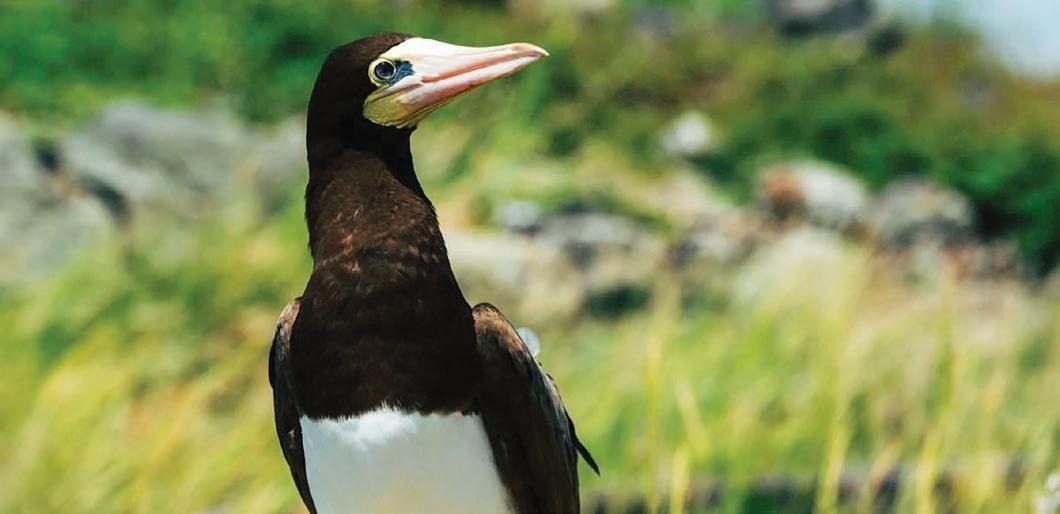
Awarded by the EPIC Team to Sherrel Charles for "Beaks of Pink and Blue: Redonda's 1%" in honor of EPIC's co-founders, whose early research showcased Caribbean seabirds and their life on land, in the air, and in the sea.

Awarded by the Caribbean Compass team to Roy van Zutphen for “Wind, Waves & Ultimate Freedom” celebrating an image that captures the spirit of exploration across the Caribbean.



CHECK OUT ALL OF THE WINNING PHOTOS epicislands.org/photo-contest-winners/2025
Thank you to all who entered or voted, to our judges for their time, and to our sponsors IGY Marinas and Horizon Yachts International for helping us connect people and places through a shared sense of responsibility. Keep in touch and support these efforts at epicislands.org/donate.
The real delight came as we were approaching Tobago and the setting sun turned the sky into one of those breathtaking Caribbean sunsets that sets the clouds on fire. My dad spotted them first. “Dolphins!” he exclaimed, “on the bow!” It was a pod of a couple dozen bottlenose dolphins, and we hurried forward to watch them glide through the water just inches from our hull, racing ahead and jumping in tandem, rolling alongside to show us their white bellies. They were more generous with their time than the pilot whales, and delighted us with their displays for what must have only been 10 minutes, though it was so spectacular the memory of it feels longer.


We inevitably arrived in Charlotteville after dark, which was less than ideal. The anchorage is deep, and space is limited since much of it is a fishing priority area. I knew moorings had been installed in the northeast corner of the bay in recent years, so we headed that way. We could see some boats gathered, but the mooring balls were difficult to spot. We finally saw one next to the headland. It seemed awfully close to the rocks. Was it a mooring, or a bleach jug marking a fish pot? Our motoring about while loudly debating mooring options got the attention of the handful of other boats in the area, and it wasn’t long before one kindly dinghied over to help us tie up to what was indeed a mooring. In the morning, we brought them a copy of the Windwards guide, and they gave us directions to




the Customs and Immigration offices.
The customs officer was kind and enthusiastic, though there was a moment of panic when we realized that, due to a miscommunication, my dad had only gotten our papers stamped by immigration before leaving Trinidad, and not by customs. After apologizing and declaring our honest intention to follow the regulations, the officer made some calls and faxes and got our paperwork in order.
I spent the rest of the day exploring and updating the Charlotteville content. It’s a quiet town with just over 1,000 inhabitants, and while most of the buildings have been modernized with concrete, a few wooden clapboard houses, trimmed in delicate lace fascia, remain. One thing that hasn’t changed is the traditional fishing industry. As we walked down the long sandy beach, we came upon a group of fishermen pulling a seine net ashore as the frigatebirds and seagulls swooped, trying to secure a cut from the boiling mass of writhing silver jacks.
The nonprofit Environmental Research Institute Charlotteville (ERIC) was a new addition to town. They installed and continue to maintain the 15 moorings in the bay, which help manage the relationship between visiting yachts and fishermen. They also do underwater research and monitoring, and have a PADI dive center and teach courses.
We rented a car from a local bar owner for the going rate of $300 TTD (about US$50) per day, and to my surprise and delight, it was a hybrid. We drove up and over the center of the island and through the Tobago Main Ridge Forest Reserve, a birdwatching haven and the oldest legally protected forest reserve in the world. We spent the following days exploring the serene bays and sandy beaches of the north coast, the restaurants and more lively holiday areas around Store Bay and Pigeon Point, and chatted with other cruisers about their experiences in the islands.
Too soon, it was time to return home to Grenada. For cruisers debating the passage south, Trinidad & Tobago offers far more than safe storage and skilled boatyards. From the warmth of the people to the wildness of the landscapes, it’s a place that rewards those who make the extra effort to get there.
The updated Trinidad & Tobago sailing guide content is available digitally on the Doyle Guides mobile app.




















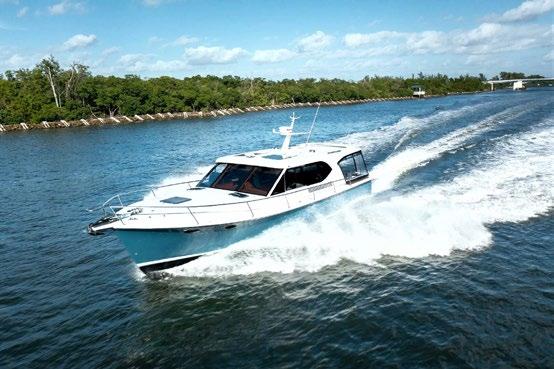



















By Chris Doyle
I ate a lot of breadfruit when I first came to Grenada in the 1960s. I was with my partner, Nikki (later my wife), and we lived on an ancient wooden 30-foot Colin Archer in St. George’s Lagoon. Having no immediate income, we dined on the cheapest market food available and that was (and still is) breadfruit. Nikki added variety by boiling and mashing half of it and frying the rest. It didn’t have a good reputation. When a friend dropped by and we invited him to join us, he quickly declined.
I’ve eaten breadfruit cooked in embers on the beach, as dainty breadfruit balls in a hotel, in Grenada’s national dish “oil-down,” and as stark slabs of starch in a few restaurants. I have seen the descendants of the trees Bligh brought to the Caribbean in St. Vincent’s Botanical Garden.
When Compass contacted me and asked me if I would like to review a close-to-300-page book on breadfruit, I was not sure, but reading the introduction sold me. Russell Fielding is an infectious optimist, writing with a spirit of adventure, and this proved to be an entertaining and even joyful experience.
Fielding rightly starts in the Pacific. But since this review is for a Caribbean audience and that was also my perspective, I want to dip first into the Caribbean.
He tells in detail how the breadfruit came to the Caribbean, including the infamous mutiny on the Bounty during Captain William Bligh’s first attempt. Breadfruit was bought to the Caribbean from the Pacific islands at the behest of the plantocracy, as an easy and inexpensive source of food for their slaves. Slaves generally had to produce their own food. They were given land to plant, and some time to cultivate and cook for themselves. The less time they needed to spend on their gardens, the more work they could do. The planters were delighted when Bligh brought the first breadfruit trees to the Caribbean, but it did not work out quite the way they hoped. The slaves were not impressed and tended to feed breadfruit to the pigs. This has become embedded in Caribbean culture.
For much of its history in the region, breadfruit was distrusted by many, even despised by some. V. S. Naipaul, of Trinidad, derisively called breadfruit “cheap slave food” in his classic travelogue The Middle Passage. Antigua-born author Jamaica Kincaid wrote about “the much-hated breadfruit,” and as recently as 1999 she could still say that “no West Indian that I know has ever liked it.”
—Continued on page 21





—Continued from the page 18
Russell Fielding is too much of an optimist to dwell long on this and is more interested in its new acceptance:
Breadfruit, now an ingredient in the “national dishes” of at least three Caribbean countries (oil-down in Grenada; stewed saltfish, spicy plantains, seasoned breadfruit, and coconut dumplings in St. Kitts and Nevis; and fried jackfish with roast breadfruit in St. Vincent and the Grenadines), is being reclaimed like the islands themselves.
But this colonial cloud still casts a shadow on attitudes to breadfruit in the Caribbean, even if the clouds are lifting.
In the Pacific, breadfruit fed islanders long before Europeans arrived. Here it is often known as ulu, the name Fielding uses, and it has no colonial cloud. Traveling with the author to the Pacific was like visiting a new world and thinking about breadfruit in a fresh way.
The ulu (Artocarpus altilis) is a tall and wide tropical tree, growing up to 85 feet high. It has glossy, green, deeply indented leaves. It produces hundreds of roundish fruits often weighing five or six pounds each. Polynesians generally start new trees using suckers, root cuttings, or air layering. A new tree from a sucker starts fruiting in just three to five years (seeds take longer).
Pacific Islanders co-evolved with the ulu; they made it what it is today. It fed and blessed them. When a baby was born, the islanders would dig a hole, plant the umbilical cord, and then plant a breadfruit tree on top, so the infant would have food. They made dishes, alcoholic drinks, surfboards, parts for their canoes, and bark-cloth from the tree and its fruit. They used the white sap to make a sticky trap to catch birds, and when they caught one, they would steal some feathers for decorations and release it. They used the sap to treat ciguatera poisoning (I could find no evidence that it worked). When they went voyaging, they carried fermented or dried breadfruit to eat and saplings to plant.
For the Polynesians, pre-colonization was a time of plenty, a full, easy, pleasurable and relaxing life. Europeans, never much inclined to thoughtful praise of indigenous people, observed the inhabitants and the breadfruit without giving much thought to how they got there. For many, including the
painter Paul Gauguin, and the mutinous crew of the Bounty, it was seductive. To the more puritanical who regarded their lifestyle as evil indolence, it was anathema.
But for us sailors, a big attraction of the Polynesian story is reading about the long ocean voyages under sail on large outrigger canoes. Fielding covers this well. Polynesian sailors navigated using stars, understanding ocean swells and observing bird life. In this manner they colonized new Pacific islands and made trips back. When Westerners arrived with their compasses and celestial instruments, they began to conclude this was not possible and decided that the Polynesians colonized other islands just by chance and luck. However, one English sailor, Dr. David Lewis, studied Polynesian navigation and carried out a successful voyage using what he learned. (One crew member was taking sextant sights but hiding them.)
—Continued on page 25
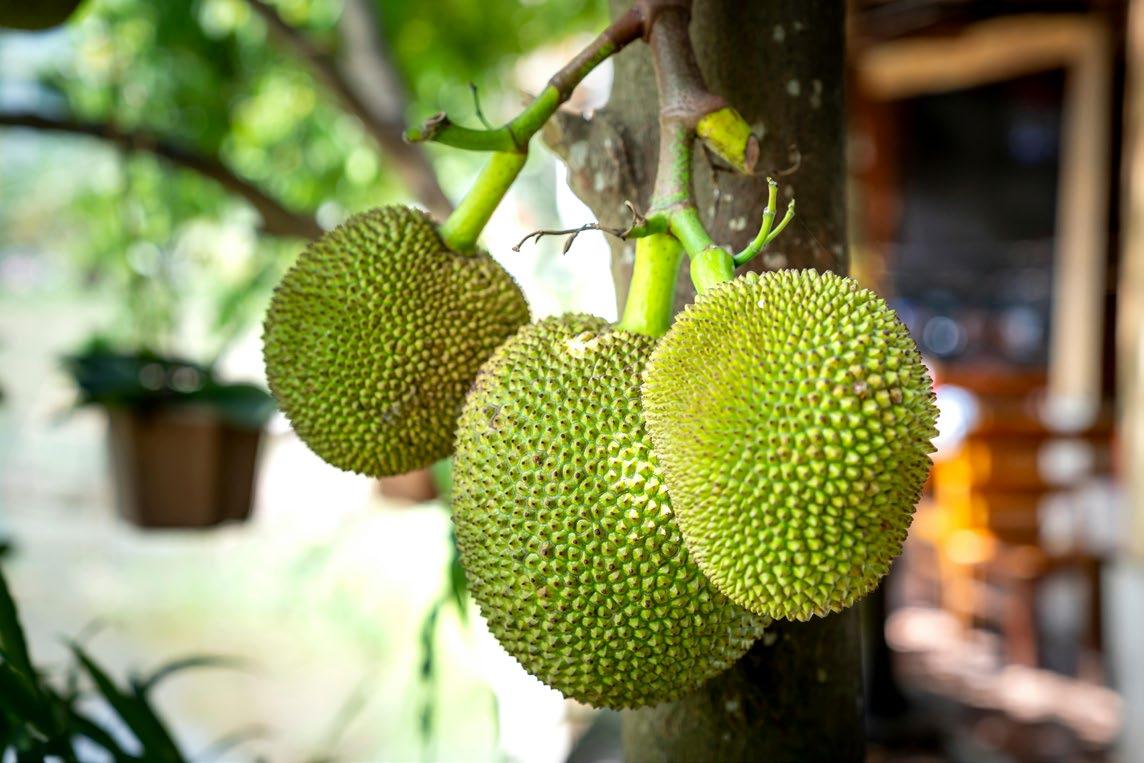


Parts & Power
Kubota Engine and Generator Parts & Service
Caribbean Distributor • Fish Bay, Tortola (284) 494-2830 • info@partsandpower.com
Import Supply
Sub Base, St. Thomas mark@importsupply.com 340-774-1679
Caraibes Diesel Services
Marigot, St. Martin info@caraibesdiesel.com 590-690-76-96-52
Marine Power Service
Falmouth Harbour, Antigua info@mpsantigua.com 268-460-1851
AM Electrical Solutions Christ Church, Barbados parts@amesolutions.net 246-418-0325
Palm Tree Marine Clarkes Court Boatyard, Grenada mike@palmtreemarine.com 473-443-7256
MRC Curacao Industriepark, Curacao kristy@mrc-carib.com 5999-738-1700
Story and photos by Claudia Colli

At one time the sight of men hammering and sawing boat frames was as common as the fast cargo-carrying sloops they produced. But as fiberglass vessels became the norm over the last 50 years or so, the territory’s traditional boatbuilding industry has mostly died out, and it is only recently that there has been renewed interest in this once vibrant trade.
In the mid 1970s, I met a traditional boatbuilder who had set up shop beneath a tamarind tree on Tortola’s West End where C&D Superette (formerly Big Ben’s) is now. I was fascinated by this aspect of Virgin Islands culture, which even then was fading into a footnote of history.
The boatbuilder’s name was Edwe Hodge, and at 41, he had been building boats at various West End locations for over 20 years. Hodge learned his trade from his father when he was 15. His father constructed Tortola sloops, boats of elegance and functionality used for inter-island trade. But by the time Hodge took up boatbuilding, these classic beauties were already on the way out. Instead, he concentrated on building fishing boats; first ones for rowing, and then newer designs for outboard motors with flatter bottoms and a keel that was part of the craft’s internal spine. He believed that the local boatbuilding industry was dying out because young people had lost interest in the trade.
Hodge constructed the boat frame from white cedar because of the ease with which it can be fashioned into the required rib shapes. For the planks he preferred imported pitch or white pine because of their greater width. I watched Hodge carefully plank the hull, insert strips of cottony caulking material between the wooden planks and sand the hull to a smooth finish. He then finished the craft’s interior and the hull with several coats of antifouling paint.
Painting the boat (usually a bright red or blue) was left to the owner. “My boats are hardly ever the same,” he told me. “I try to make them better each time.”
Spanning back almost 200 years, boat construction in the islands began shortly after the abolition of slavery in 1834. The collapse of the plantation way of life prompted the departure of much of the white planter population, and the 9,000 or so remaining former slaves were left to live a hand-to-mouth existence by farming and fishing.
The majority of early boats were either rowing boats or small sloops for fishing. But soon, larger sloops and schooners were built to accommodate an increasing trade in produce, livestock and seafood with neighboring St. Thomas. Not only were the Virgin Islanders adept in the art of boatbuilding, they developed vessels singular to this area.

According to Edwin Doran, a writer and early observer of these boats, “Tortolan craft are distinctive in form and represent a boat type with a long history built by local artisans in conformance to a long-accepted style.”
The Tortola sloop had many unique characteristics including an overhanging stern and stem, pronounced sheer, considerable keel drag, a sloop rig with strongly raking mast and a boom extending far aft of the transom. At one time hundreds of sailing vessels were seen plying these waters. Doran bemoaned the fading away of these classic boats and the long maritime history here in the Virgin Islands that they represented. Others interested in preserving the history of the Tortola sloop include Foxy and Tessa Callwood. Owners of the popular Foxy’s Bar and Restaurant on Jost Van Dyke, and founders of the Jost Van Dykes Preservation Society, the couple spearheaded an exceptional boatbuilding project on their home turf. Endeavour II was built over the course of several years under the guidance of experienced boatbuilders with several young local apprentices helping out. A hybrid of traditional and modern construction techniques, the boat was intended as a learning tool in boatbuilding construction.


The H. Lavity Stoutt Community College has also been in the forefront of preserving the islands’ classic boat tradition. The college has had five boats under its wing, including the 25-foot Youth Instructor, built by the East End boatbuilder Osmond Davies; the Esmie, constructed by Leondo Nibbs in 2000, and the oldest, built in 1914, Intrepid This historic sloop, discovered in St. Croix, was purchased by VP Bank and donated to the college. Two other boats, Sea Moon and Moon Beam, were built by Anegada boatbuilder Watson White. Unfortunately, several of these precious craft were damaged in Hurricane Irma in 2017.
Geoffrey Brooks, a local maritime historian, has been instrumental in the upkeep and promotion of the sloops. He is the author of the children’s book, Building a Virgin Islands Sloop: The Story of Sea Moon, which was illustrated by noted BVI artist Lutai Durant, and depicts the boatbuilding efforts of Anegada boatbuilder White.
Rekindled interest in the boats, both here in the VI and throughout the Caribbean, was highlighted in the documentary Vanishing Sail, an inspiring documentary about the traditional boatbuilding industry in the Grenadine
can be rented by going to the filmmaker’s website. vanishingsail.com
To watch a trailer go here: youtube.com/ channel/UCnb4PiSP93lNwmix87fvLOQ
Artist Aragorn Dick-Read, a long-time supporter of Caribbean classic boats, noted that indigenous cultures, including the Taino Indians that once populated the BVI, hand-built canoes to traverse the seas around these islands. Aragorn, along with a group of Carib Indians in Dominica, built such a canoe which he now keeps outside his studio in Trellis Bay on Beef Island.
“As these classic Caribbean boats decrease in numbers, they have become increasingly valuable, and a resource to be treasured,” he said.
Classic boat enthusiasts throughout the islands hope that the spark of the BVI’s boatbuilding tradition will remain alive. This article was originally published by The BVI Insider. For more stories on the British Virgin Islands go to thebviinsider. com. For additional info on the BVI’s history log on to thebviinsider.com/ people-and-heritage.
Claudia Colli is the publisher of The BVI Insider. For three decades, she served as the publisher and editor of the Welcome Guide to the British Virgin Islands, where she lives. In addition to those roles and freelance commissions, she is the author of two guidebooks to the BVI: Introducing the BVI, and British Virgin Islands: Sheltered Isles of Sea and Sun, published by Macmillan.
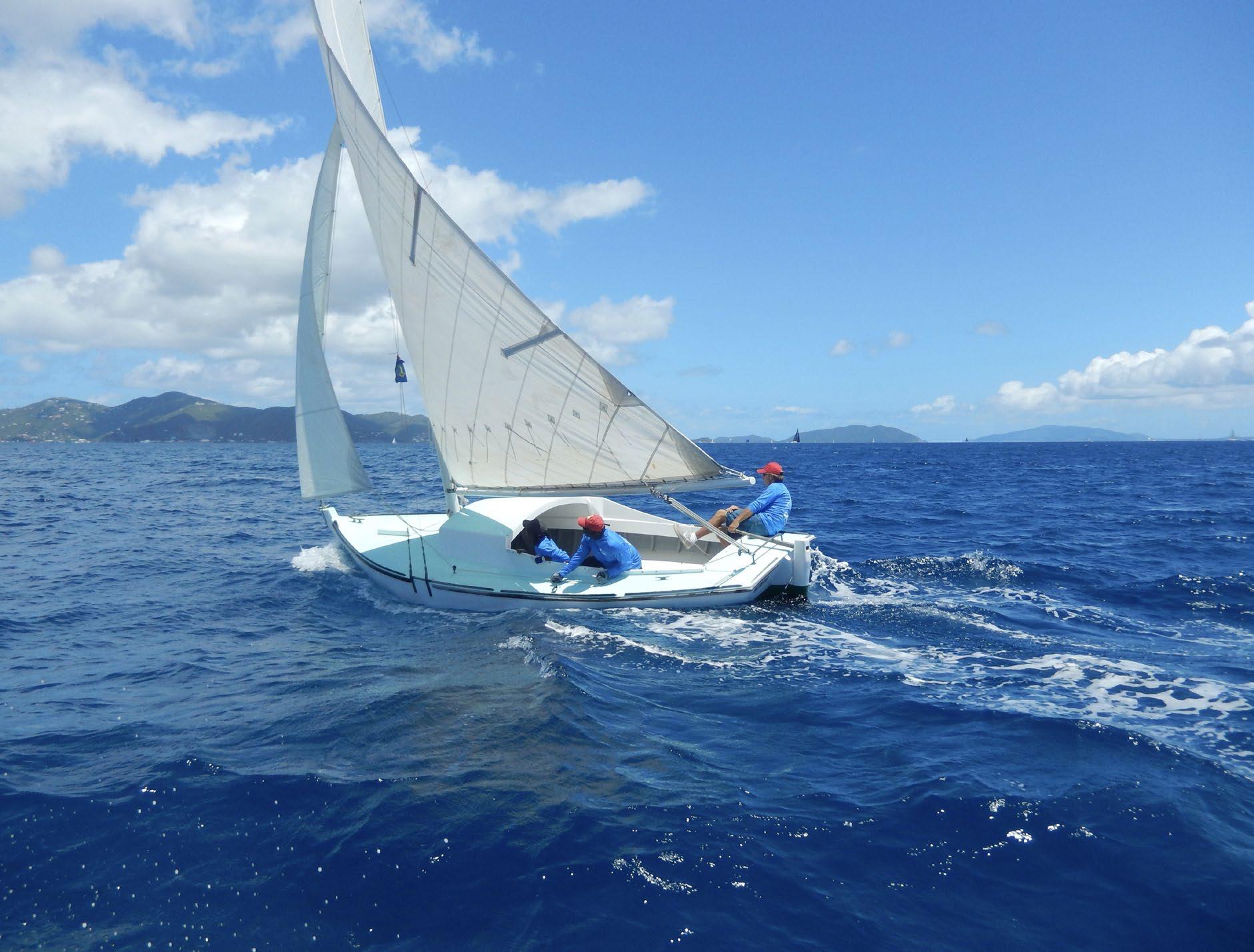

S
M ARIN A DOC K S
150 slips accommodating monohulls
MOORING S
S UP E RYACH T DOC K
B OAT YA R D S
Now accommodating Catamarans & Monohulls !
H a u l O ut & St o rag e:
Storage on stands or cradles. Masts, dinghies, outboards.
O n si t e Trad es in cl u d e: Mechanics, marine electrics/ and boat management. All other trades available as needed
—Continued from page 21
Lewis also spent time with anthropologist Ben Finny, who knew him and wanted to document a genuine voyage. Finny founded the Polynesian Voyaging Society, built a traditional ocean going proa, Hokule’a, and contacted Mau Piailug, one of the original navigators. In 1976, using no modern navigation methods, Mau successfully navigated from Hawaii to Tahiti, a voyage of over two thousand miles.
Coincidentally, I once stayed for a few days with David Lewis in England aboard his catamaran Rehu Moana before an early transatlantic race.
Fielding researched this book through reading and extensive travel. One of its delights is that he takes you along with him on his adventures and introduces you to many of the people he meets along the way. Another pleasure is that every time you turn a page, you seem to find some aspect of life, history, and breadfruit that is immensely pleasing. This about the Florida Keys:
Near Phil’s market, at the “Little White House,” the winter residence of President Harry Truman, a large, perfectly pruned breadfruit tree grows at the side of the yard, its branches just reaching over the fence toward the sidewalk.
I had no idea Presidents Thomas Jefferson and Truman were both interested in breadfruit. It is not surprising. The breadfruit tree is amazingly productive and its copious fruits are a good source of complex carbohydrates, with fiber, antioxidants, and Vitamins C and A. It would be an asset to any country. However, it is very susceptible to the cold and in the USA, Hawaii and the warmest parts of Florida are the only places it can grow.
In a world where 20 percent of the population has insufficient food, the further spread of the breadfruit tree may be part of the solution. This is a recurring theme of the story Fielding tells. He describes breadfruit’s introduction and propagation in many countries, including several in Africa. I mentioned this to Grenadian Dennis Henry who had just returned after many weeks in several African countries. “Yes,” he said, “I saw some.”
The fruit of the ulu has a short shelf life. It looks fine from the outside but the moment you stop paying attention, it suddenly turns into an overripe mess. So to feed more of the world, breadfruit products with a good shelf life, such as flour, are essential.
Fielding also introduces the reader to people working with breadfruit. Many Caribbean islands’ agricultural departments help with this. In Barbados, where he meets Sonia, who produces Carmeta’s Fine Breadfruit flour, this is the Barbados Agricultural Development and Marketing Corporation (BADMC).
My first question was an obvious one: who is Carmeta? The answer was not so simple, only because Carmeta Fraser was such a complex figure in Barbadian food history. A tireless advocate for the role of self-sufficiency in food security, Fraser was known for her down-to-earth approach. She taught classes on food preservation techniques, hosted cooking programs on television, and wrote cookbooks with recipes that relied heavily upon Barbados-grown ingredients and spun simple maxims like, “Eat what you grow; grow what you eat.”
A few paragraphs later:
Sonia gave me cards with recipes for breadfruit fish cakes and breadfruit great cake, the latter of which, in addition to breadfruit flour, calls for twelve ounces of stout, two cups of rum, and a cup of brandy. Maybe that will convince a few culinary novices to give cooking a try.
Fielding casts his net wide and well, and covers many topics, from global warming and celiac disease to origin myths, gourmet chefs, economics and cultivars. I was happy I read it on my computer as I often had to look things up on the internet, the strangest being “cockroach milk.”
I enjoy reading about nature, but rarely have I read a book devoted to a single tree. This book, like the breadfruit tree itself, is rich, productive, and full of surprises and delights such as you can eat breadfruit skin.
When peeling a raw breadfruit for one of these recipes, don’t toss the skin into your compost! If the fruit was washed well first, strips of ulu skin can be panfried in butter or oil, then lightly seasoned with salt and pepper to make a delicious version of hashbrowns. My children say this is their favorite breadfruit recipe.
Fielding writes much about breadfruit cooks, processes and cooking ideas. But it is not a recipe book. I am going to buy Sam Choy’s Ulu Cookbook: Hawaii’s Breadfruit Recipes, which Fielding recommends, and I did find a link to Carmeta’s recipe for breadfruit great cake here: badmc.org/wp-content/uploads/2022/04/ BADMC_Carmeta_s-Recipe-Advertorial_16Dec151.pdf.
Breadfruit: Three Global Journeys of a Bountiful Tree Russell Fielding, Columbia University Press, New York, 2025.




A RIGID-HULLED INFLATABLE THAT GIVES YOU A LITTLE EXTRA!
If you want to take a step above the norm in a hard-bottom tender, step up to a deep “V” fiberglass hulled Achilles HB-DX or a lighter version HB-LX.
The Achilles boating experience begins with probably the best inflatable CSM (Hypalon) fabric on the market today, a deep-V hull and large diameter tubes. This results in a dry, safe, and comfortable ride for you and your guests.
Proven quality that will last! Trust your next inflatable boat to the proven name in fabric reliability, durability and toughness – Achilles.
NOW available at Island Water World.


Achilles boasts over 40 years of experience in producing probably the highest quality CSM on the market today. Their confidence is backed up by a 5-year warranty on fabrics & seams.

CSM exterior for toughness
Heavy-duty Nylon or Polyester core fabric
Two layers of Chloroprene for unsurpassed air retention
Achilles CSM fabric has a proven track record in handling the burning sun of the tropics and the salty Caribbean waters with high resistance to fading or deterioration.
NON-CORROSIVE CHECK VALVES
All Achilles valves are non-corrosive with no moving parts that might break. They are engineered for easy “one-way” inflation and instant deflation.
UNSURPASSED SEAM CONSTRUCTION
The seams are overlapped a full inch and reinforced with seam tape both inside and out.

This is propably the strongest four layer seam construction in the industry.

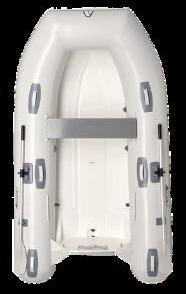
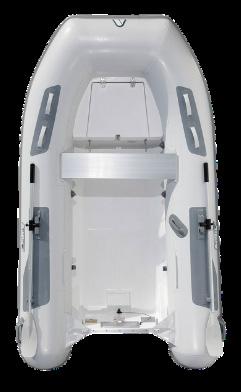
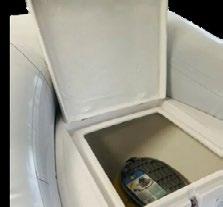

1 Public holiday in Antigua (Independence Day), including the Antigua and Barbuda Independence Food Fair
1 Public holiday in several places (All Saints Day)
1 Barbados Pork Festival visitbarbados.org
3 Public holiday in Dominica (Independence Day)
4-7 Music Tourism Convention, Anguilla
4-9 St. Barths Gourmet Festival. saintbarthgourmetfestival.com
5 FULL MOON (Beaver Moon – Super Moon)
5-9
Barbados Open Water Festival, Carlisle Bay. Barbadosopenwaterfestival.com
5-12 Havana Jo Jazz Festival. cubagrouptour.com/us/information/eventsin-cuba
6-9 Barbados Food and Rum Festival, Bridgetown. foodandrum.com
7 Environmental Friday: Autobiography of a Teenage Environmentalist by Jayda Ramjattan. 9:30am EST, Zoom Meeting ID: 834 1808 4388
7-9 Afro Nation Punta Cana, Dominican Republic. puntacana.afronation. com
7-9 Itz’ana Wahoo Classic Fishing Tournament, Belize
7-10 USVI Charter Yacht Show, St. Thomas. usviyachtshow.org
8 Best in the West Fishing Tournament, Antigua. ABYMA.org
8 William Thornton Race and Virgin’s Cup, BVI. royalbviyc.org/racing.html
8-15 Pirate Week, Grand Cayman. Piratesfestcayman.com
8-16 Havana Theater Festival
9 ARC+ leaves Las Palmas de Gran Canaria for Grenada.
9 Coral Reef Swim Race, St. Croix. swimrace.com
10-16 St. Barts Rum Festival. caribbeanrumawards.com
11-14 BVI Charter Yacht Show. Crewedyachtsbvi.com
11-22 Festival de la Gastronomie, Saint-Martin. festival-st-martin.com/en
14 Environmental Friday: Role of Citizen Science in Biodiversity by Corey T. Callaghan, University of Florida. 9:30am EST, Zoom Meeting ID: 834 1808 4388
13-16 Jamaica Cup Tennis Tournament, Montego Bay. JamaicaCup.com
13-16 Jamaica Food and Drink Festival. jafoodanddrink.com
16 Marabana Marathon, Cuba.cubagrouptour.com/us/information/ events-in-cuba
19 Overseas Fishing Rodeo, Belize. fishingbelize.org/tournament
19-23 St. Barth Cata Cup. stbarthcatacup.com
20-23 Jolly Harbour Yacht Club Annual Regatta, Antigua. jhycantigua.com
21 Environmental Friday: Biodiversity, Extinction, and Climate Change by John J. Wiens, University of Arizona. 9:30am EST, Zoom Meeting ID: 834 1808 4388
21-22 Pirate Week, Cayman Sister Islands. Piratesfestcayman.com
22 Nanny Cay Round Tortola Race, BVI. royalbviyc.org
22-25 Alliouagana Festival of the Word, Montserrat. facebook.com/AFWLitfest
23 Keelboat Season Championship, Race Day One, St. Maarten. smyc. com/keelboat-season-championship/
26 – 2 Dec Antigua and Barbuda Art Week
27 Thanksgiving, US territories
27-30 St. Maarten Budget Marine Optimist Championship. smyc.com/dinghyseason-championship
28 Jump-Up, St. Croix
28 - 30 Anegada Lobster Festival, Anegada, BVI
28-30 Mango Bowl Regatta, St. Lucia. facebook.com/MangoBowl
30 Public holiday in Barbados (Independence Day)
23 Atlantic Rally for Cruisers (ARC), Las Palmas de Gran Canaria to Rodney Bay, Saint Lucia. stlucia.org/en/experiences/festivals-events/
TBA Habana Clasica Music Festival. cubagrouptour.com/us/information/ events-in-cuba
TBA Imagine Weekend, Barbados. visitbarbados.org
See the entire calendar of events at caribbeancompass.com/caribbean-events-calendar

• Mercury Dealership
• Full Chandlery
• Marine Store and Yard Services
• Mercury Dealership
• Dockage – 44 fixed slips
• 5 Available Moorings
• Full Chandlery
• Maximum vessel size: 125 Feet
• 40 Ton, 17.5’ Max Beam Travelift
• Haul and Launch
• Fuel Dock – Gasoline and Diesel
• WIFI
• Washrooms and Showers
• Dockage – 44 fixed slips
• Ice and Beverages
• 5 Available Moorings
• Maximum vessel size: 125 Feet
• 40 Ton, 17.5’ Max Beam Travelift
5063 Gallows Bay, Christiansted, VI 00820 Tel: 340-773-0289 | Hail VHF 16 info@stcroixmarinecenter.com www.StCroixMarineCenter.com
• Marine Store and Yard Services
• Haul and Launch
• Fuel Dock – Gasoline and Diesel
• WIFI
• Washrooms and Showers
• Ice and Beverages

Gallows Bay, Christiansted, VI 00820 Tel: 340-773-0289 | Hail VHF 16
info@stcroixmarinecenter.com www.StCroixMarineCenter.com

Positioned atop a curving archipelago that extends from the Florida Keys, south to the islands of Trinidad & Tobago, the British Virgin Islands have emerged as the sailing capital of the Caribbean. History documents the attention given these islands from explorers, traders, historians, adventurers, and pirates, but perhaps nothing has influenced both the history and sailing sector growth more than the geography and physical makeup. Blessed by the steady northeast trade winds and the proximity of the 36 islands and islets, each with their respective sheltered coves and inlets, the BVI is a sailor’s paradise and tropical charter epicenter.
Cruising Grounds
One could spend months exploring the possibilities of these cruising grounds. Two parallel lines of islands extend almost 35 miles east and west, forming Sir Francis Drake Channel. There are four main islands, Tortola, Jost Van Dyke, Virgin Gorda, and Anegada, around which are the numerous smaller islets and cays ready to explore. At the western end, Jost Van Dyke is known for its barefoot-in-the-sand vibe, beach bars and low-key restaurants serving excellent island cuisine. Foxy’s and Soggy Dollar have become famous with sailors around the world. When the sun goes down on “Jost” the sounds of island rhythms go up with partying that continues late into the night.
Sailing east up the channel, the islands of Norman, Peter, Cooper and Salt all have their own treasures to explore. The Baths on Virgin Gorda are a spectacular formation of large igneous boulders. Called batholiths, they rise from the sea forming a series of natural caves and grottos accessible from the beach for some exploration.
The North Sound on Virgin Gorda offers a water-sports haven anchored by iconic establishments such as Bitter End, Saba Rock, Leverick Bay, and Oil Nut Bay and Marina.
Fifteen miles to the north of Virgin Gorda lies the low coral and limestone island of Anegada. There, sailors congregate to explore seemingly endless beaches on the reef-lined north shore, and to enjoy sunset dining on lobster at water’s edge. Conch Mountain, located on the south shore, is literally a mountain of conch shells, carbon dated back to the 13th century.
Getting there and getting around
Each year sailors from both sides of the Atlantic converge on the Caribbean to discover the cornucopia of cultures that make the region so desirable. Sailors from the USA make their way down through the islands of the Bahamas or directly from East Coast gateways. European arrivals usually make landfall farther south in the Windward Islands, then meander north to the BVI. For those chartering vessels, air access is both direct to the Tortola/Beef Island Airport (EIS) or via Puerto Rico (SJU) or St. Thomas (STT) where daily flights or ferries to the BVI are abundant. BVI is a British overseas territory. The government is a parliamentary democracy regulated by the Constitution of the British Virgin Islands. BVIslanders, as they are called, are predominantly of African descent, stemming from the islands’ plantation history. Currency is the US dollar and credit cards are largely accepted throughout the island chain. The spoken language is English; however, the locals also use an Englishbased creole that is a rapid idiomatic form delivered with a characteristic island rhythm.


The territory of the British Virgin Islands has officially trademarked its reputation as a sailing capital.
Located in the northeast trade wind belt, the BVI is blessed with excellent sailing conditions almost year-round. During winter months, when wind conditions are at their highest (18-30 knots), the geographical makeup of the island chain affords shelter to the sailing area. This makes for easier sailing conditions than one might logically experience farther to the south.
The BVI overall would be considered one of the safer destinations in the Caribbean. Though, occasional theft or petty crime is possible. Visitors are advised to regulate themselves accordingly. Dinghies should be locked or lifted out of the water at night. Don’t bring expensive jewelry or leave cash/credit cards lying around and do lock your boat when leaving.
—Continued on the next page
—Continued from the previous page
Medical resources are available throughout the island. The main hospital is in Road Town on Tortola, with various clinics on Virgin Gorda, Jost Van Dyke and Anegada. Virgin Island Search and Rescue (VISAR) is a volunteer nonprofit which provides a professional 24-hour emergency service throughout the territory. Its crews respond to medical emergencies free of charge.
Visitors are allowed 30 days at entry after which an immigration extension is required. Vessels remaining in the BVI will need to apply for a temporary import license. A BVI Parks Permit can also be obtained at Customs. This provides access to the BVI National Parks and use of the mooring system at locations like the Baths on Virgin Gorda.
Marine Services and Support
Heavily influenced by the growth of the charter trade, marine support services have expanded dramatically at both the technical and service ends of the spectrum. Provisioning can be ordered online for delivery to your vessel from the major supermarkets (Riteway or One Mart). Pre-prepared provisioning is also available at individual providers such as Elite Culinaire (eliteculinaire. com).
There are two major boatyards with large capacity, Nanny Cay on Tortola and The Virgin Island Yacht Harbour on Virgin Gorda. Nanny Cay has storage for 260 vessels with two lifts capable of handling monohulls up to 68 feet and catamarans to a 32-foot beam. The 200-slip marina is home to multiple charter fleets and supporting technical service providers are in abundance along with a well-stocked chandlery. Virgin Gorda Yacht Harbour has dockage for 90 yachts with a max length of 180 feet. The marina complex has enjoyed a revitalization which will continue into 2026 and incorporate provisioning and deli services, rooftop bar, dive services etc. The boatyards are supported by two travel lifts and have a max capacity of 400 vessels. Technical services are available on site.
Recognized as one of the world’s top dive destinations, the BVI has become synonymous with the Wreck of the Rhone, regarded by many as the best wreck dive in the western hemisphere. Superb reefs for both snorkeling and diving are found in and around many of the anchorages. Numerous dive operators have programs to suit all levels and sailors can arrange for the dive companies to rendezvous at most of the more popular anchorages.
The BVI National Parks Trust maintains moorings for daytime use with permit. These moorings support both dive and snorkel


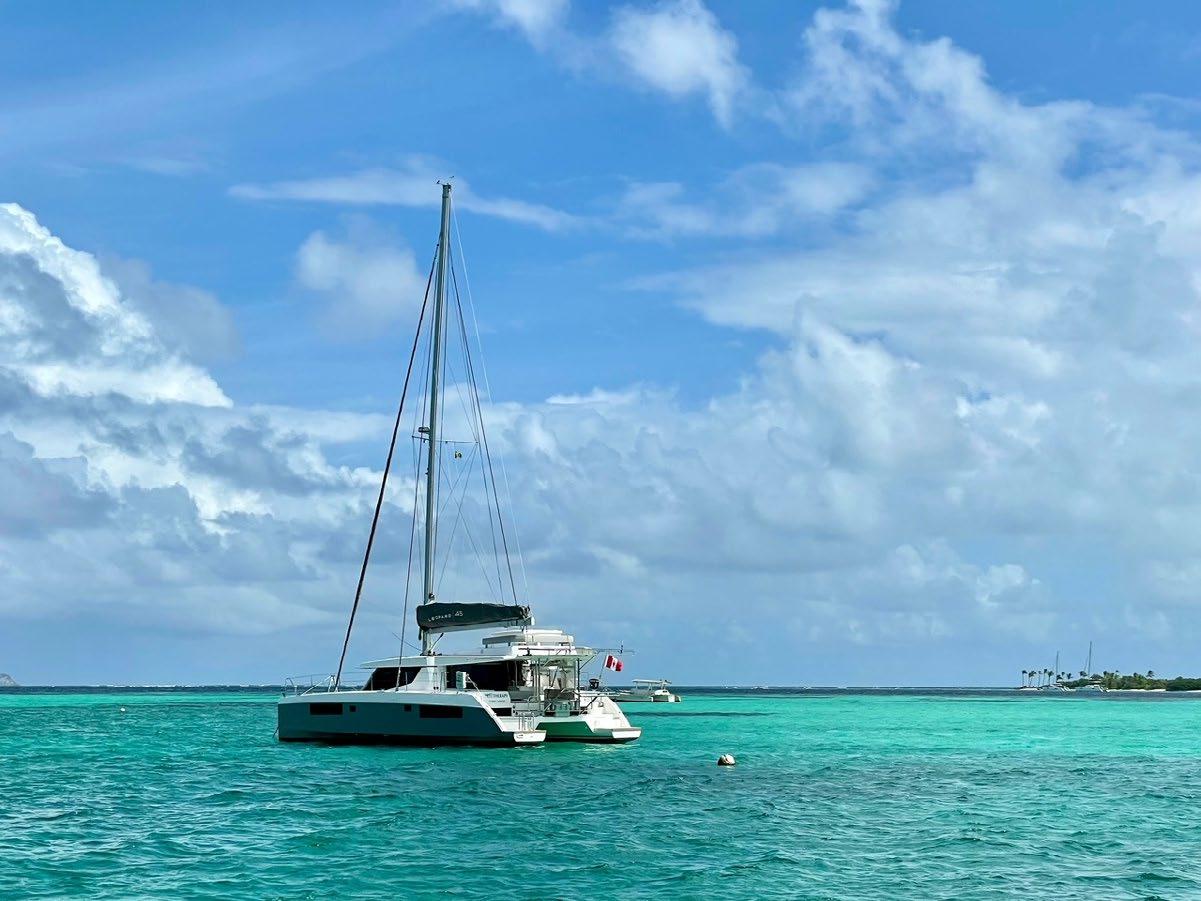

sites along with sensitive sea bed areas in need of protection.
For more information on the Virgin Islands and the sailing areas of the Caribbean pick up a copy of the latest 2026 edition of the Cruising Guide series or download the CruisingGuide app on both the Apple and Google stores or visit us at cruisingguides.com.
Ports of Entry:
There are four ports of entry for the BVI: two on Tortola, one on Jost van Dyke, and one on Virgin Gorda. West End/Soper’s Hole on Tortola is a popular entry/exit port for cruisers due to its proximity to the USVI. Spanish Town is the main harbor on Virgin Gorda and is the westernmost entry/exit port. See BVI Main Ports for more details on the ports of entry.
https://www.noonsite.com/place/british-virgin-islands/#mainports
Advance Paperwork:
The BVI uses the SailClear system. Boats should preregister and submit arrival notification.
For many countries, a visa is not required. BVI immigration authorities typically issue a one-month entry stamp on arrival.
Vessels are granted up to 180 days before requiring a Temporary Import Permit (increased from 30 days September 2025).
Entry Process:
On arrival, the captain should immediately proceed to the nearest Customs and Immigration offices with the SailClear ID number, crew passports and boat paperwork. Reserved dress is recommended (no bathing suits/beachwear).
Exit Process:
Same as the entry process; the captain clears out in person at a port of entry with SailClear ID number, crew and boat documents.
Rates:
For a double handed yacht, entry and exit costs are approximately USD $100.
Check https://www.noonsite.com/place/british-virgin-islands/view/ clearance/ for more detailed information and updates.

This information is provided by http://noonsite.com, specialists in worldwide formalities for yachts, and was accurate at press time.
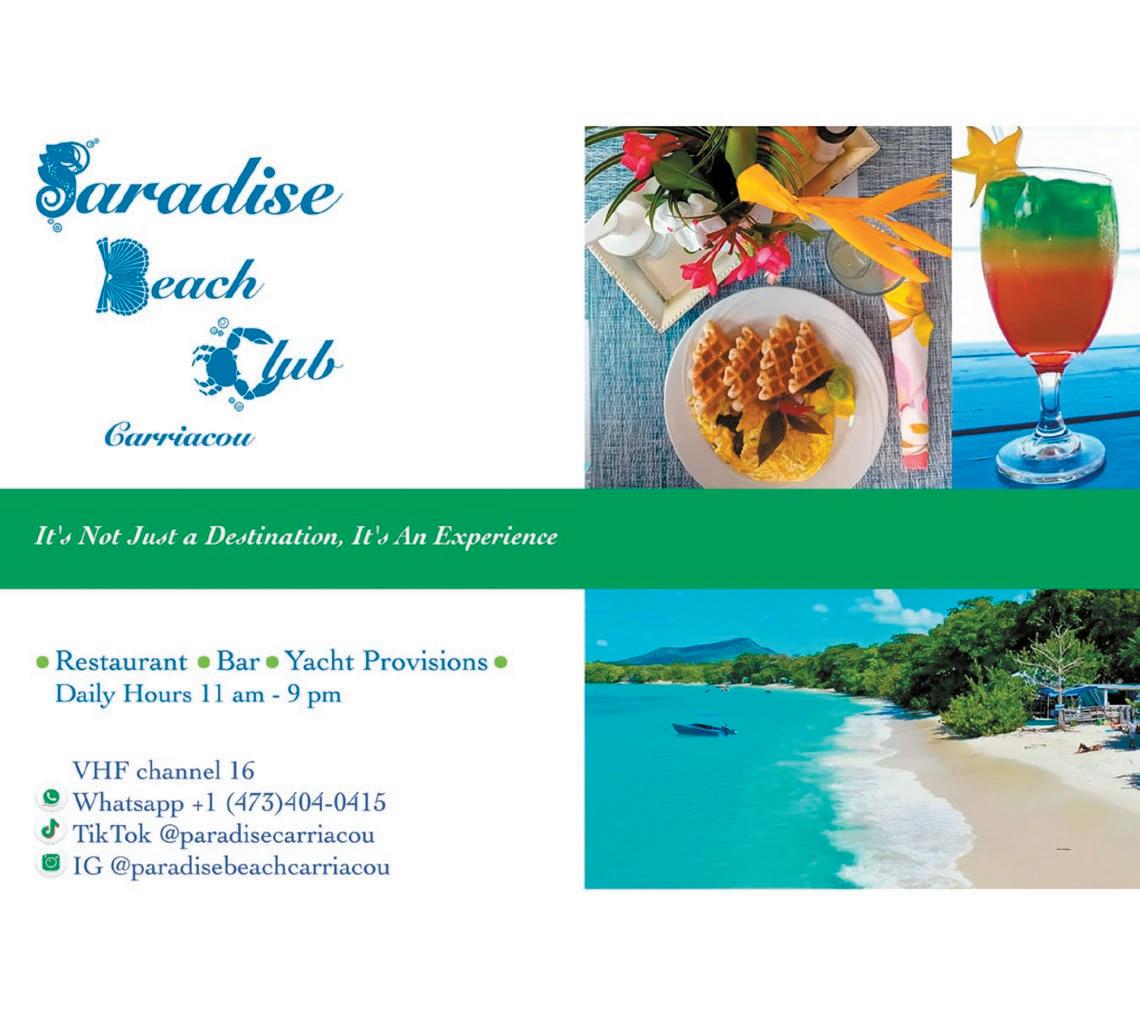
PT-9900-144 HORTA / FAIAL, AZORES
Providing all vital services to Trans-Atlantic Yachts!
Incl. Chandlery, Charts, Pilots, Rigging EU-VAT (16%) importation
TEL +351 292 391616 Junes@mail.telepac.pt www.midatlanticyachtservices.com


Check out our website or contact us directly for a competitive quote on rugged and well-built sails that are well suited to the harsh environment of the charter trade and blue water cruising.
Jeff Fisher – Grenada (473) 407 6355 www.neilprydesails.com







gsailsbequia@gmail.com








